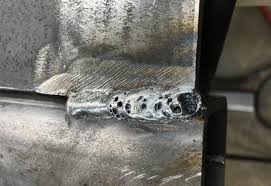Comprehensive Overview: What is Porosity in Welding and How to avoid It
Wiki Article
Deciphering the Enigma of Porosity in Welding: Tips for Lessening Issues and Maximizing Quality
In the complex world of welding, porosity stays a relentless obstacle that can dramatically impact the high quality and stability of welded joints. As we dig right into the depths of porosity in welding, discovering the keys to its prevention and control will certainly be paramount for professionals looking for to master the art of premium weldments.Comprehending Porosity in Welding
Porosity in welding, a typical concern encountered by welders, describes the presence of gas pockets or gaps in the welded product, which can endanger the honesty and quality of the weld. These gas pockets are commonly entraped throughout the welding process due to numerous aspects such as inappropriate shielding gas, contaminated base materials, or inaccurate welding parameters. The formation of porosity can weaken the weld, making it prone to fracturing and deterioration, eventually bring about structural failings.By acknowledging the importance of preserving appropriate gas shielding, guaranteeing the cleanliness of base materials, and optimizing welding setups, welders can significantly decrease the likelihood of porosity development. On the whole, a comprehensive understanding of porosity in welding is vital for welders to produce high-quality and durable welds.

Typical Root Causes Of Porosity
When inspecting welding processes for prospective high quality problems, understanding the typical reasons for porosity is important for preserving weld honesty and preventing structural failures. Porosity, defined by the visibility of cavities or voids in the weld steel, can considerably endanger the mechanical residential properties of a bonded joint. One typical source of porosity is incorrect protecting gas protection. Poor shielding gas flow prices or inappropriate gas mixes can result in climatic contamination, causing porosity formation.
Another common reason for porosity is the presence of wetness and pollutants externally of the base metal or filler material. When welding materials are not appropriately cleansed or are revealed to high levels of moisture, the evaporation of these contaminants throughout welding can produce gaps within the weld grain. In addition, welding at incorrect parameters, such as exceedingly high traveling speeds or currents, can produce extreme disturbance in the weld pool, capturing gases and triggering porosity. By addressing these common reasons through proper gas shielding, product preparation, and adherence to optimal welding specifications, welders can decrease porosity and boost the top quality of their welds.
Methods for Porosity Avoidance
Carrying out efficient preventive steps is crucial in lessening the event of porosity in welding processes. One method for porosity avoidance is making certain proper cleaning of the base metal before welding. Contaminants such as oil, oil, rust, and paint can cause porosity, so complete cleansing making use of proper solvents or mechanical techniques is vital.
Another secret preventative action is the option of the appropriate welding consumables. Making use of high-quality filler products and shielding gases that are ideal for the base metal and welding process can significantly decrease the risk of porosity. check that In addition, maintaining appropriate welding parameters, such as voltage, present, take a see this site trip rate, and gas circulation rate, is important for porosity prevention. Deviating from the recommended setups can result in inappropriate gas insurance coverage and inadequate fusion, causing porosity.
In addition, using proper welding strategies, such as maintaining a constant travel rate, electrode angle, and arc length, can assist prevent porosity (What is Porosity). Ample training of welders to guarantee they follow finest methods and high quality control procedures is likewise necessary in lessening porosity issues in welding

Best Practices for High Quality Welds
One trick practice is preserving proper sanitation in the welding location. Completely cleaning the workpiece and surrounding location before welding can aid alleviate these issues.Another ideal method is to thoroughly pick the proper welding specifications for the specific products being signed up with. Appropriate parameter choice makes certain ideal weld penetration, fusion, and overall high quality. Using premium welding consumables, such as electrodes and filler metals, can dramatically impact the last weld top quality.
Importance of Porosity Control
Porosity control plays a vital function in ensuring the integrity and quality of welding joints. Porosity, defined by the presence of tooth cavities or voids within the weld metal, can dramatically jeopardize the mechanical residential properties and architectural integrity of the weld. Extreme porosity weakens the weld, making it more prone to splitting, corrosion, and overall failure under operational tons.Effective porosity control is vital for keeping the desired mechanical buildings, such as stamina, ductility, and durability, of the welded joint. What is Porosity. By minimizing porosity, welders can improve the overall top quality and dependability of the weld, making certain that it fulfills the next performance demands of the desired application
In addition, porosity control is essential for achieving the preferred visual appearance of the weld. Too much porosity not only weakens the weld but likewise detracts from its visual charm, which can be vital in industries where looks are crucial. Correct porosity control strategies, such as utilizing the proper securing gas, controlling the welding specifications, and guaranteeing proper tidiness of the base products, are necessary for producing high-grade welds with marginal issues.

Verdict
In final thought, porosity in welding is a common defect that can endanger the high quality of the weld. It is important to control porosity in welding to guarantee the integrity and strength of the last item.Report this wiki page